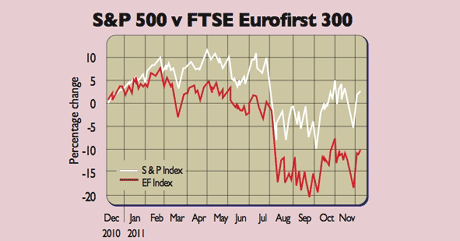
Good news stories are like London buses, says FxPro.com: nothing for ages, then several come along at once. Last week global stockmarkets had their best week in more than two years, with US and British stocks jumping by more than 7% and the pan-European FTSE Eurofirst 300 index gaining 8.5%.
One reason to cheer was that China allowed its banks to lend more, so the authorities are now propping up growth. A slide in the US unemployment rate also fostered optimism. But the main boost came from joint action by central banks in the eurozone, Britain, America, Switzerland, Canada and Japan to alleviate the credit crunch in the European banking sector.
Easing the credit crunch
The move has “created a sense that those with their hands on the tiller are finally resolved to fix the problem”, says Tom Stevenson in The Sunday Telegraph. European Central Bank (ECB) president Mario Draghi reinforced these hopes. He hinted that the ECB might go on a bond-buying spree in the troubled ‘periphery’ nations (the likes of Greece, Italy and Spain) provided there is progress towards fiscal union. With banks increasingly worried about their counterparties’ exposure to dodgy European sovereign debt, a funding squeeze has developed in wholesale banking markets, as we noted last week.
One particular problem for European banks has been getting hold of dollars. US money-market funds, a traditional funding source, have fled, and it has become increasingly expensive to borrow dollars from US banks in exchange for lending euros. Central banks have now relieved the strain in this dollar swap market. The Fed has lowered the interest rate on dollar swaps by 0.5%, making it easier for other central banks to swap their currencies into greenbacks, which can then be lent on to liquidity-squeezed banks in their region.
Will the stock rally last?
Since the credit bubble burst, none of the equity-market rallies triggered by joint central bank action have lasted, says James Mackintosh in the FT. “This one too looks doubtful.” The policy moves have provided more liquidity, but Europe’s banks have a solvency problem. “Giving them cheap dollar funding… stops the withdrawal of American funds blowing them up immediately.”
But banks’ exposure to shaky peripheral debt means that the threat of insolvency still looms if countries default. This move just buys time. It tackles symptoms, not the cause, of the credit crunch, agrees Nick Kounis of ABN Amro. “This is not a game changer.”
America’s not out of the woods…
It’s also not worth getting over-excited about America’s prospects. The 0.4% drop in the unemployment rate to 8.6% last month was largely due to discouraged workers dropping out of the labour force. The economy has a bit of momentum, says The Economist, and could expand at 2.5% or so for a year, but don’t expect a growth surge. “There’s still too much private and public deleveraging to go.” And there’s still the danger of the economy being derailed by a meltdown in Europe, says John Mauldin on Investorsinsight.com.
… and neither is Europe
Which brings us back to the debt crisis. Before the latest summit, France and Germany seemed focused on “creating fiscal rules to prevent future crises” instead of upping their support to resolve this one, says Capital Economics. No sign yet of fiscal union, eurobonds, or the ECB being a lender of last resort, says Ambrose Evans-Pritchard in The Daily Telegraph. “Just the usual blather.” Italy has put forward an austerity package, but no detail yet on structural reforms to boost growth. Ratings agency Standard & Poor’s has threatened to downgrade core economies, which is bad news for confidence. The market bounce following the grand bargain from Europe may prove to be fleeting.